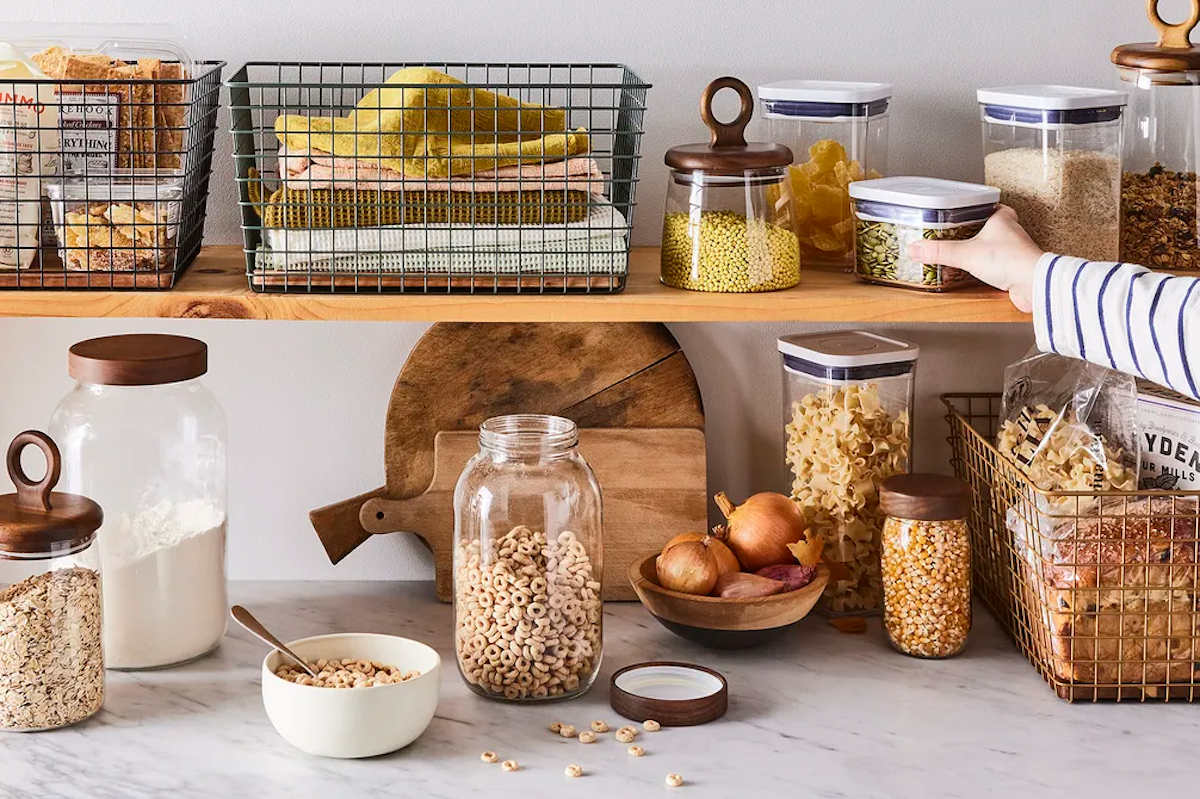Floods in Kentucky. Fires out west. Hurricane season in the South. And with winter right around the corner, it's time to consider how prepared you are for natural disasters. The CDC recommends Americans have, at any given time, at least a three-day supply of water and food that doesn't require refrigeration or cooking. That kind of cushion, said FEMA experts in an interview, can give you enough time to figure out your next move in the event of an emergency.
"If you're buying a case of soup or a big container of Jif peanut butter from Costco, you're prepping," said Eric Christianson of Nutrient Survival, whose company entered the so-called "emergency food market" in 2020. "A lot of people think it's about fear or panic, but it's about being prepared and being smart about it, especially if you have family, elderly, kids, [or] pets. You need to be ready."
A new (emergency) frontier
Augason Farms, a 50-year-old Salt Lake City-based shelf-stable food company, witnessed the impact of September 11th, the Iraq War, the Ebola virus, and Y2K. Any time individuals prepared for disaster and supply chain disruptions, says Mark Augason, president of Augason Farms, they stocked their pantries and refrigerators, eager to keep themselves fed during what could be a long-time outage of typical services. His company sells powdered milk, rice mixes, pasta, soup, and pancake mixes that can last for up to 25 years. The pandemic, however, shattered records for Augason Farms and other emergency food suppliers. Americans suddenly had to shift the way they prepare for crises, especially as they become more prevalent due to climate change, social and political turmoil, and health emergencies.
"There [was] nothing like [the] pandemic," Augason said. "Every person saw the supply chain stop, and we all saw grocery stores empty."
Prior to 2020, Augason said, his company was earning about $50 million in revenue annually. Today, it's more than $200 million. Since the pandemic struck, emergency preparedness has been more important than ever before.
Tim Waller, chief marketing officer for ReadyWise, a "preparedness bundle" supplier, thinks emergency food is about to become less niche.
For a long time, those who bought buckets of emergency food were writing prepper blogs or, as Waller points out, assumed practitioners of religions that call for preparation. ReadyWise, like several similar companies, is based in Salt Lake City, which Waller attributes to the Mormon Church's tenet calling for preparation.
"It was always [suggested that] that, at the end of the world, you should make sure to have your food storage," he said. "So, culturally, it's already baked in as an easier sell."
When the pandemic hit, though, "our sales absolutely boomed," he said. ReadyWise revenue has increased by about 600% since 2019. "When you have that uneasiness of, 'Oh, is the grocery store going to have food?' ... things could go south, and you'd be fine. You have [a] runway."
How it works
How do long-term non-perishable food products work? ReadyWise uses a common process: They freeze-dry food, removing as much liquid and oxygen as possible and then package it in airtight containers. The success of the process makes for a surprisingly diverse line of products, often packaged compactly and sold together in variety buckets that don't take up much room in a pantry or closet. Depending on the company, consumers can choose from fruits, vegetables, powdered milk and butter, shakes, pasta, chicken and rice, coffee, baked goods, soups, black bean burgers, and powdered honey. Many are intended to be mixed and matched together, in order to prevent food fatigue.
And more and more Americans are preparing for just that. In 2020, FEMA reported a record-setting 226 major disasters or emergency declarations. In 2017, 36% of Americans perceived a risk for a potential emergency in their lives. By 2021, that number had risen to 76%, and 45% of Americans had reported assembling or updating their emergency preparedness supplies.
"Disasters are unfortunately something we should all prepare for," said Jonathan Yoder, deputy chief of the CDC's Waterborne Disease Prevention Branch.
Am I filling my storage unit with this stuff today?
It's not exactly necessary to run out and buy, say, a M.O.A.B collection from ReadyWise, which includes 144 buckets that can sustain a person's caloric needs for five full years or a "Just In Case" emergency food supply Mountain House.
"A lot of people who are preparing aren't buying a year's supply. They buy what they can afford," Christianson explained.
Most emergency food lines are fairly affordable: You can get a single bucket for one person (which includes three days of just-add-water meals) from ReadyWise or Augason Farms for $40 to $45. Nutrient Survival's version is $129 and comes with a 10-liter dry bag (a waterproof bag that's easy to grab on your way out the door in a hurry).
But which tastes the best?
As demand for emergency food has expanded over the past few years, so have the products. There are some dishes you're going to see over and over again: Expect lots of pasta, freeze-dried fruits and vegetables, granola, oatmeal, and powdered eggs. There are some other unifying characteristics, too. Whether you're dipping into a supply of powdered milk, prepping a chocolate shake or warming up some pudding, ideally, you'll have access to hot or boiling water. (Not all products require hot water, but it makes the final product more enjoyable.)
Word to the wise: When using dehydrated food products, tread lightly with the amount of water suggested to mix in with each item. Nearly every food mix was soupier than I'd prefer when using the serving of water suggested on the package.
Here are our recommendations for the best emergency food supply kits.
- Best for variety: Augason Farms and ReadyWise, both of which offer variety buckets in addition to meat, dairy, fruit, and vegetable-specific bundles.
- Best for dietary restrictions: Check labels for specific allergens, but try NuManna's gluten-free family pack bucket, which is made without soy, high fructose corn syrup, or wheat. Northwest Fork also carries emergency foods that are Kosher, vegan, and free of soy, gluten, nuts, and GMOs.
- Best for longevity: Most emergency food brands guarantee products up to 25 years without loss of flavor or integrity. But not every item carries that expiration date, so check your labels. Upon my review, Augason and ReadyWise seemed to have the most options hitting the longest shelf life.
- Best for quick exits: Valley Food Storage's "Bug Out Bag" includes basic first aid, safety, food, water, and shelter needs, including 30 meal servings, all in a waterproof dry bag, for $149.95. ReadyWise also offers go-bags and boxes themed for specific natural disasters, if you like a little comic relief with your emergencies. (Slap on some 3D glasses, and the ReadyWise Earthquake Bundle box looks like it's shaking).
- Best for flavor: To taste test, I wanted to compare like items offered by each brand — in this case, macaroni and cheese, and oatmeal — as well as stand-out items from each line that seemed genuinely appealing. Augason's macaroni came closest to an EasyMac experience, which is my personal gold standard for the usual pantry staples I keep on-hand during hurricane season at home in New Orleans. For breakfast, however, ReadyWise's brown sugar and maple oatmeal was the best, both in texture and flavor.
Nutrient Survival's meat-free "Hearty Lasagna" and ReadyWise's teriyaki-style rice had the best flavor overall, each of which seemed close to a standard, off-the-shelf pantry item.
Heading into this experiment, I expect the food to taste extremely salty and mushy, but happily, that wasn't the case for any of the brands I tried. However, it was hard for me to get past the general weakness in the suggested prep method: Pour boiling water over the dry food, cover, and wait some number of minutes. It made for not quite all-the-way cooked macaroni, especially for ReadyWise, which had larger noodles, and tepid temps by the time I dug in. If I were to try cooking these kits again, I'd opt to prep them directly on my stove. (But, of course, that's not always an option in an emergency situation.)
These emergency food supply kits didn't exactly compel me to replace any of my pantry standards with their super shelf-stable editions. The next time there's a storm churning, I'll still rely first on what's already in my freezer, fridge, and standard pantry. But as a New Orleanian, will I feel a little bit better knowing I've got a bucket or two stashed in the hall closet? Absolutely. Now go get prepped — and hope you never have to use your supply.




Shares